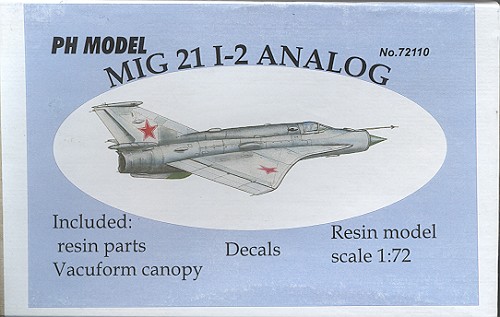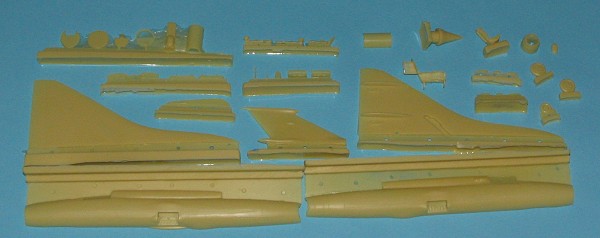
| KIT: | PH Model 1/72 MiG-21 I-2 Analog |
| KIT #: | 72110 |
| PRICE: | $23.41 from www.hobbyshop.cz |
| DECALS: | One option |
| REVIEWER: | Scott Van Aken |
| NOTES: | Resin with vacuformed canopy |

| HISTORY |
Initially designed as a fast interceptor for the Soviet Air Force, the MiG-21 was adapted to a fairly acceptable fighter bomber after the initial production variants. Though always a bit short on range, thanks to the need to keep weight down, the MiG-21 performed admirably in various conflicts and wars, though it always seemed as if it was second-best to the opponents it faced. This could easily have been due to the difference in the general quality of pilots and the tactics used.
Regardless, it was one of the most successful Soviet fighters of the 1960s and was a huge success in the export market. Many are still flying today and thanks to various systems upgrades, are still viable aircraft.
One of the more unusual uses for the MiG-21 was in the MiG-21 I-2 "Analog". This aircraft seems to be a standard MiG-21 MF that had its horizontal flying surfaces replaced with replicas of the wings to be used on the Tu-144 SST. The aircraft was used to test the wing before it was used on the Tupolev airframe to ensure that there were no major problems with this particular design. Apparently all went well and the Tu-144 was built using this shape wing. It was other problems that eventually grounded the 'Concordski' and it never enjoyed the success of the Anglo-French SST.
To my knowledge, the 'Analog' is in one of the various museums in Russia.
| THE KIT |

Cast in a standard cream resin, the kit is very nicely molded and though the sprue attachment stubs seem large, they are actually quite thin and should remove nicely. The kit is quite complete and includes not only the rather unusual wings for this version but also a nicely done cockpit complete with tub, control stick, seat and instrument panel. The tub and panel all have very nicely done raised detail. I did notice that most of the little cooling vents on the kit are separate pieces and while it would have been nice to have these molded on, it shouldn't present too much hardship. There is a single vacuformed canopy (not shown) that is only of fair quality and if one can find a better replacement, it would probably be a good idea
One thing that I will praise PH Models for is that they have molded the landing gear around strong sections of piano wire. This will prevent the weight of the model from causing the landing gear to buckle over the years. I only wish that everyone who did resin kits was so thoughtful.
The rest of the kit is pretty well straight-forward with no real challenges or surprises for anyone who has built a number of resin kits. The instructions are on a folded sheet of paper. One side has a very nicely done three view drawing of the aircraft with markings placements (a bunch of red stars that isn't shown) and any painting that needs to be done (which isn't much as it is unpainted metal with green dielectric sections). The instructions are basically a couple of exploded views intermixed with a parts drawing of the little bits. Some things are omitted (like the cockpit construction), but again, those of us who have built a few models won't find this troubling at all.
| CONCLUSIONS |
Over all, this is quite a nice kit of a most interesting prototype. It should build into an excellent model in its own right and will be very much at home in a collection of one-off research aircraft.
December 2005
You can find this kit and many others at

If you would like your product reviewed fairly and quickly by a site that has around 300,000 visitors a month, please contact me or see other details in the Note to Contributors.